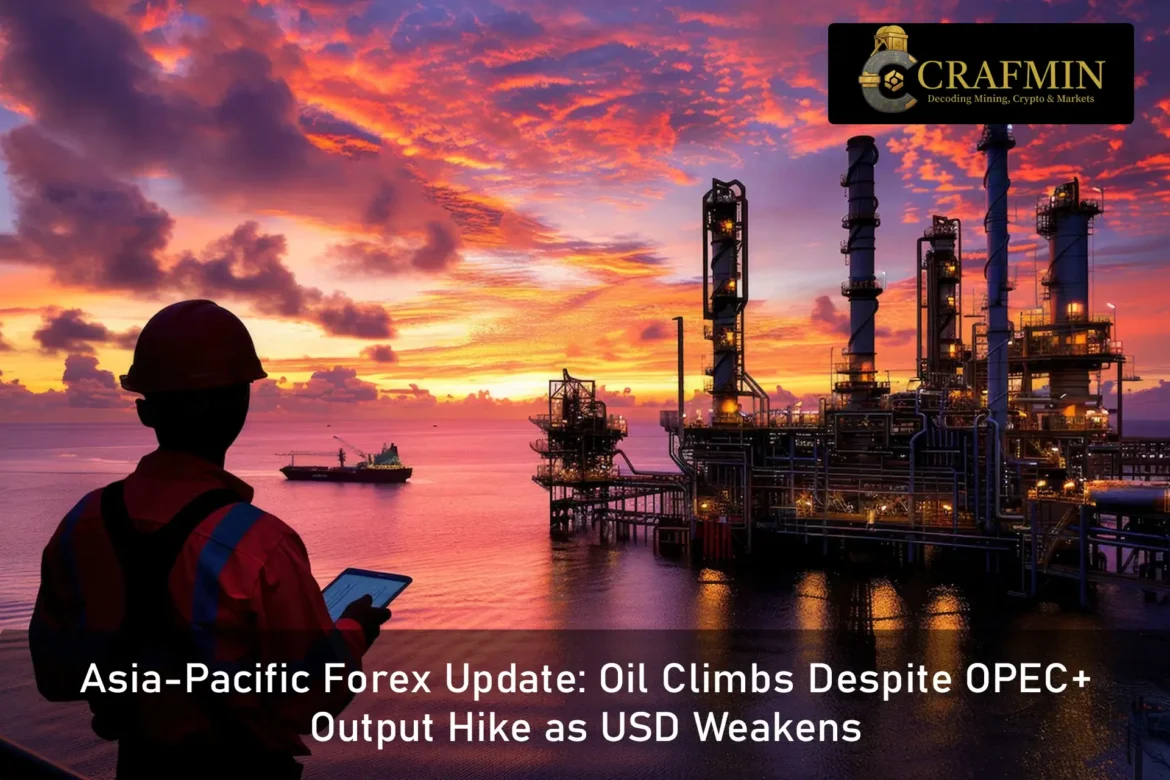In today’s Asia-Pacific trading session, oil prices have unexpectedly surged, defying the anticipated bearish impact of a fresh OPEC+ production increase. At the same time, the US dollar continues its downward drift, influenced by dovish central bank cues and shifting global risk appetite.
Let’s explore the drivers behind today’s forex and commodity market moves, and what traders should watch out for.

Oil Gains as OPEC+ Hikes Output, USD Slips ( Image Source: Economies.com )
Oil Defies Logic, Climbs on Geopolitical Risks
Despite OPEC+ announcing an output hike of around 411,000 barrels per day, oil prices are rising rather than falling. Brent and WTI futures gained momentum as the market focused less on supply figures and more on emerging geopolitical risks.
Drone strikes on Russian energy infrastructure and speculation over looming U.S. sanctions on Russian oil buyers have injected new fears of disruption into the market. Traders are responding not just to data, but to the broader geopolitical atmosphere. Oil, as usual, is behaving more like a barometer of global tension than a traditional commodity.
USD Dips as Fed Hints at Dovish Turn
The US dollar softened across major pairs, largely due to recent remarks by Fed Governor Christopher Waller. His suggestion that inflation may ease—despite tariff pressures—sparked talk of possible rate cuts later this year. That prospect is weighing on the dollar, as lower rates tend to reduce its yield appeal.
The greenback’s pullback has favoured the Japanese yen and Australian dollar, with investors rotating away from USD-heavy trades in search of better near-term returns.
Bank of Japan Sends Subtle Signal
In Japan, the central bank’s decision to allocate more reserves for potential bond losses is being interpreted as groundwork for future rate hikes. This quiet policy shift has breathed life into the yen, which strengthened against the dollar and euro.
Market watchers are beginning to recalibrate their expectations for the BoJ, long considered the last ultra-loose monetary holdout among major central banks.
AUD and CAD Gain on Energy Rally
Commodity-backed currencies such as the Australian and Canadian dollars are gaining ground, supported by the oil rally and improved risk sentiment. The AUD is also seeing upside from Australia’s strong energy export profile, while the CAD benefits directly from surging oil prices.
Both currencies are riding the risk-on mood, as equities inch up and global investors seek yield amid shifting central bank narratives.
Asia-Pacific Market Mood: A Snapshot
The Asia-Pacific session is becoming increasingly influential in global trading. Markets are reacting in real time to geopolitical developments, central bank commentary, and economic data.
- South Korea posted mixed figures—softening industrial output, but stable consumer sentiment.
- China remains under close scrutiny amid debt concerns and real estate instability.
- India stands out for its currency stability and steady foreign capital inflows.
The region’s activity is now shaping global sentiment in ways traditionally reserved for the London or New York sessions.
Also Read: GameStop and Trump Media Stocks Drop After Bitcoin Buys
Forex Meets Crypto: Growing Correlations
Forex traders are now watching crypto markets more closely. As oil prices rise and the dollar weakens, Bitcoin and Ethereum are tracking those trends with moderate gains. This reflects a new paradigm where cryptocurrencies react to macroeconomic shifts much like traditional risk assets—though with far more volatility.
This crossover is increasingly important for traders handling emerging market pairs or speculative positions tied to global risk trends.
Key Takeaways for Traders
- Oil prices are reacting more to geopolitical risks than supply data—don’t assume linear cause and effect.
- Fed signals suggest a dovish tilt—watch for policy clues that could affect USD strength.
- Volatility is the new normal—use protective strategies like stop-loss orders.
- Cross-asset links are stronger than ever—commodity moves can ripple into forex pairs.
- Asia-Pacific sessions now drive early market tone—stay alert during these hours, especially for commodity-linked trades.
Final Thought: Asia Takes the Lead
The assumption that Asia’s trading hours are quieter no longer holds. With central banks shifting tone, oil markets reacting to geopolitics, and currency moves originating in Tokyo and Sydney, the region is now a key driver of global market dynamics.
Traders, whether beginners or veterans, should treat the Asia-Pacific session not as a warm-up—but as a core part of the daily trading cycle. Big moves are happening before the Western world wakes up—and that’s where opportunity lies.

